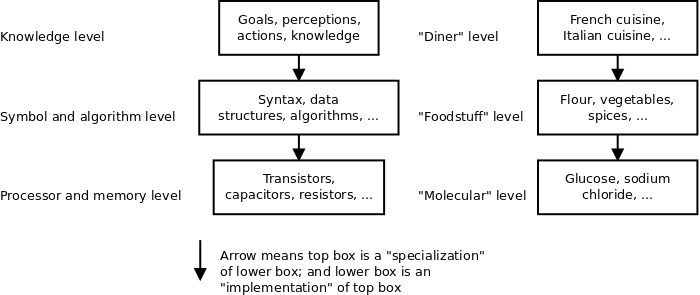For those new to the field of AI, the terminology may be somewhat abstract. We talk about ”goals,” ”actions,” ”perceptions,” and ”knowledge.” But what are these concepts? How do they relate to more familiar terms?
New terminology is often a feature of a field of study; perhaps, terminology is partly what defines a field of study as separate from others. But the terminology is not just a way for a field to differentiate itself. The terminology is necessary to properly understand what is being investigated and explained.
In the philosophy of science, there is much interest in figuring out what constitutes an explanation. What is generally agreed upon is that an explanation should tell a “causal story” by including specifics about how events effect others. This causal story should enable one to imagine how different configurations could cause different outcomes (i.e., the causal story should support a mental model). An explanation also should be non-obvious and hide irrelevant details. In short, an explanation should be at a certain “level” of description; not too high-level as to be completely vague, and not too low-level as to make the mental model or causal story so complex that alternative outcomes cannot be easily imagined.
Imagine trying to explain the role of a four-chambered heart while being restricted only to the concepts and terminology of molecular chemistry. The role of the heart, what it does for the animal, cannot possibly be described with such terminology. Molecular chemistry plays a role in every organ, every cell, of the animal, so the language of chemistry is not capable of explaining why a heart is special.
Now, imagine trying to describe how a computer program sorts a list of numbers by using only concepts and terminology about logic gates, resistors, capacitors, etc. While it could be done, the explanation of the sorting procedure would be extraordinarily complex and, frankly, completely non-explanatory. We could not answer the question, if this logic gate was instead wired to that logic gate, how would the sorting algorithm change? No one is capable of holding a mental model with such complexity.
Likewise, imagine trying to explain Freud’s Oedipus complex (boy loves his mother, wants to kill his father) in terms of neurons, dopamine, synaptic plasticity, …
Explanations that are too “high level” are also worthless. We will not understanding the human heart, how it works and why we each have one, if we speak at the level of societies and nation-states (whose constituents all have hearts). Again, there is no causal story, so there is no explanation.
The point is that there are more-or-less natural and obvious levels of explanation. The heart is best explained in terms of its role in blood circulation and the body’s need for oxygen (simplifying a bit). A sorting algorithm is best explained in terms of programming language constructs (such as lists, loops, comparison operators, etc.). And the Oedipus complex is best explained in terms of the id/ego/superego, castration anxiety, and so on.
These levels of explanation form hierarchies. Here is a basic hierarchy for computer systems and food:
A higher-level layer is an specialization of its next-lower layer. In these examples, a particular set of programming language instructions specialize the electronic circuitry; the instructions make a particular use of the circuits. Similarly, various foodstuffs combine basic molecules in particular ways.
Likewise, each lower-level layer is an implementation of the next-higher layer. Foodstuffs are “implemented” in physical form with glucose, dextrose, etc. And computer software is implemented in electrical circuits. Perhaps there are different possible implementations. Software, at least, could be “executed” by hand (pencil & paper). In the past, programmers executed their code by hand, when computers were not available for every person all the time.
Finally, each level can be defined independently of its higher and lower levels. We can define exactly what transistors are; it does not matter how they will be used (maybe to build a familiar computer, maybe not), nor does it matter how they are implemented. Programmers generally never concern themselves with transistors and capacitors. A programmer can think about a problem in terms of data structures and algorithms and get along just fine.
When we design and build AI systems, we find that explanations stuck at the symbol and algorithm level are too verbose. For many larger software systems, it makes no difference how it is coded nor in what language. This is especially true for AI systems. There is something else about them. They require a higher level of description than descriptions like “this is how we sort a list of numbers.” Why sort the numbers? What do the numbers represent?
In AI, we find it more useful to talk about ”goals,” ”actions,” ”perceptions,” and ”knowledge.” A goal is something the system (the agent) wants to accomplish. A perception is information the agent obtains about its environment. An action is something the agent can do in order to change its environment. And knowledge is consulted in order to choose the right actions, based on perceptions, in order to achieve goals.
Exactly how goals, actions, perceptions, and knowledge are implemented (realized in code) is not important if we are only describing what the goals, actions, perceptions, and knowledge are. Their descriptions, their explanations, exist in a level above the symbol and algorithm level. Allen Newell calls this level the ”Knowledge level.” Perhaps we can define a similar level in the food domain, which I call the “diner” level, i.e., the level of description that restaurant patrons care about.
We can explain how AI systems work using only the terminology from the knowledge level. This is what gives AI its own set of terminology, and partly what makes AI a separate field of study (separate from software engineering and electrical engineering, for example).

